This article previously appeared in the Spring 2016 Long Trail News.
The northern hardwood forest is the common forest type below 2,500 feet in Vermont’s Green Mountains. Yellow birch, sugar maple, American beech, eastern hemlock and white pine dominate, shading hobblebush, several species of ferns, shining clubmoss, and many species of fungi.
Ephemeral spring wild flowers such as trout lily and painted trillium bloom in the short window as snow melts and temperatures become milder, before tree leaves block sunlight from the forest floor. Black-capped chickadees, white breasted nuthatch and downy woodpeckers are residents year round. White tailed deer, moose, black bears, porcupines and red squirrels call the northern hardwood forest home.
Here is an introduction to some forest community members:
Artist’s Conk Ganoderma Applanatum
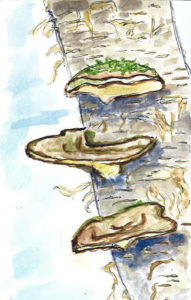 Artist’s conk is a species of polypore, or shelf fungus. It is the fruiting body of a mycelium that grows in both living and dead tissue of several tree species in the northern hardwood forest, causing sapwood and heartwood rot. The visible fruiting body is large, shelf-like, and woody, and can grow for many years. Spores are released from the underside of the fungus, which also happens to make a good medium for etching or drawing, hence the common name.
Artist’s conk is a species of polypore, or shelf fungus. It is the fruiting body of a mycelium that grows in both living and dead tissue of several tree species in the northern hardwood forest, causing sapwood and heartwood rot. The visible fruiting body is large, shelf-like, and woody, and can grow for many years. Spores are released from the underside of the fungus, which also happens to make a good medium for etching or drawing, hence the common name.
Downy Woodpecker Picoides Pubescens
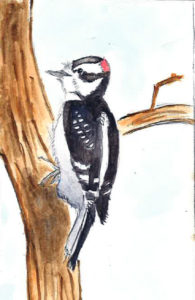 The downy woodpecker is North America’s smallest woodpecker and a common year round inhabitant of the northern hardwood forest. It is very similar to the hairy woodpecker, but has a smaller bill and lacks black spots on its white tail feathers. Both have a rectangular “white blaze” on the back that makes them easy to identify. The downy woodpecker is a noisy bird with a distinct “whinnying” call. It taps and drums on trees as it searches for insects or excavates a nest cavity or winter roost. Its small size enables acrobatic foraging, climbing and perching on small branches using its stiff tail feathers for balance. Like other woodpeckers it undulates as it flies through the forest from tree to tree.
The downy woodpecker is North America’s smallest woodpecker and a common year round inhabitant of the northern hardwood forest. It is very similar to the hairy woodpecker, but has a smaller bill and lacks black spots on its white tail feathers. Both have a rectangular “white blaze” on the back that makes them easy to identify. The downy woodpecker is a noisy bird with a distinct “whinnying” call. It taps and drums on trees as it searches for insects or excavates a nest cavity or winter roost. Its small size enables acrobatic foraging, climbing and perching on small branches using its stiff tail feathers for balance. Like other woodpeckers it undulates as it flies through the forest from tree to tree.
Shining Clubmoss Lycopodium Lucidulum
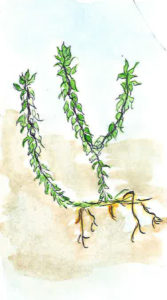 Shining clubmoss, an evergreen relative of ferns, is found among the leaf litter of the forest floor. Underground horizontal rhizomes enable it to spread into mats or tufts of this small but conspicuous plant. Like ferns and horsetails, clubmosses have a primitive reproductive strategy that involves the release of spores that must land on wet surfaces for a complete life cycle, limiting where it can grow and reproduce. An ancient plant, clubmosses evolved around 410 million years ago, and grew in much larger form in the coal swamps of the Carboniferous period, from 360 to 300 million years ago.
Shining clubmoss, an evergreen relative of ferns, is found among the leaf litter of the forest floor. Underground horizontal rhizomes enable it to spread into mats or tufts of this small but conspicuous plant. Like ferns and horsetails, clubmosses have a primitive reproductive strategy that involves the release of spores that must land on wet surfaces for a complete life cycle, limiting where it can grow and reproduce. An ancient plant, clubmosses evolved around 410 million years ago, and grew in much larger form in the coal swamps of the Carboniferous period, from 360 to 300 million years ago.
North American Beaver
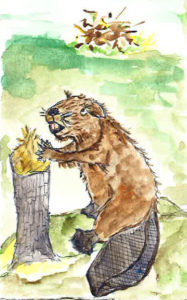 Trail Name: Castor Canadensis
Trail Name: Castor Canadensis
Gear: Large incisors (front teeth) for felling trees, webbed hind feet for swimming; flat, leathery tail for steering underwater, storing fat, and slapping to startle potential predators and warn other beavers of them.
Shelter: Freestanding lodges made of branches, logs and mud, or dug-out bank dens, with tunnels that exit underwater in both cases. Usually built in a pond, often created by the beavers by damming a stream; or in or on the banks of larger rivers.
Trail Food: Leaves, inner bark, and twigs of favorite trees including birch, aspen, red maple, alder and cottonwood. Also ferns and aquatic plants.
Water Treatment: None. Beavers often carry the pathogen giardia, which contaminates water. Always carry a filter or water treatment drops while hiking in beaver country!
Community: Beavers often mate for life, and kits remain with adults until they are almost two years old. Sometimes muskrats live with a beaver family in their lodge, making it a full shelter!
Pace: Slow waddlers on land, but fast swimmers in water.
Favorite Long Trail Section: The pond south of Tillotson Camp, Griffith Lake and other southern ponds, or any section with streams and bogs.
Trail Magic: Beaver dams create ponds where beavers build their lodges, store food, and are safe from predators. This is trail magic for many other animals including ducks, wading birds, muskrats, frogs and turtles, because it gives them an aquatic habitat and food.
On your next hike, examine the shelf-like artist’s conk fungi up close. Look for the white blaze on the back of the downy woodpecker as it taps on the trees of the hardwood forest. Imagine giant prehistoric animals walking among the giant prehistoric forms of club mosses as you pass its diminutive modern form on the forest floor. And when you follow the trail next to a pond listen for the slap of the North American beaver’s tail. You will start to notice the many animals and plants of our Long Trail community, and the more you know about it, the more fascinating it becomes.
–Squirrel (Carrie) Johnson
Squirrel is a former GMC Long Trail Patrol leader, backcountry caretaker, and information specialist at the club’s Visitor Center. Squirrel has hiked many miles including the Long Trail, Appalachian Trail, Pacific Crest Trail, Colorado Trail, and Continental Divide Trail.




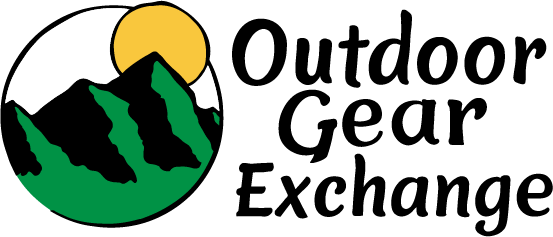














Leave a Reply